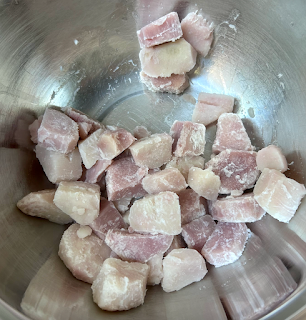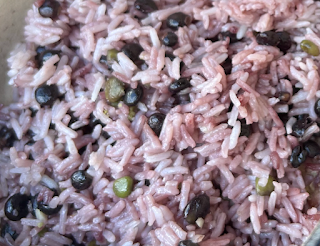Guacho – Wacho
En cuanto a la comida panameña, no es ningún secreto que mi favorita es la cocina caribeña panameña. Así que hoy les comparto otro plato favorito: un contundente llamado guacho (que se pronuncia 'wacho'). El guacho es un guiso de arroz típico de la costa caribeña panameña. Los guachos tradicionales llevan rabito de puerco, carne, pollo o mariscos. Hay muchísimas variantes.
El arroz blanco tostado se cocina en caldo y, a menudo, con leche de coco. En cuanto al proceso de cocción, se asemeja a un risotto o una paella, pero con un toque caribeño panameño. Es similar al asopao puertorriqueño. Primero, se saltea una mezcla de verduras, especias, cebolla y ajo en una olla grande para hacer un sofrito. Estas verduras suelen incluir ajo, cebolla, pimientos, tomate, ají chombo, yuca y batata. A veces, el guacho se condimenta con curry en polvo y siempre lleva culantro. Luego, se agrega el arroz y se tuesta en la sartén. Poco a poco, se añade el caldo y la leche de coco, y el arroz absorbe el líquido mientras se cocina.
Una vez listo para comer, el guacho se sirve caliente. Aunque nunca lo probamos, este sustancioso guiso sería perfecto para un frío día de invierno. Tiene una consistencia caldosa, por lo que siempre se sirve en un tazón. Luego se añade una guarnición de sofrito por encima, junto con un poco de culantro.
When it comes to food in Panama, It's no secret that I love Caribbean Panamanian cuisine the most. So today I'm sharing another favorite, a hearty dish known as Guacho, (pronounced 'wacho'). Guacho is a typical rice stew from the Caribbean coast of Panama. Traditional guachos have rabito de puerco (pig tail), meat, chicken or seafood. There are so many variations.
Once it's ready to eat, the guacho is served hot. Even though we never have them, this hearty stew would be perfect for a cold winter's day. It is soupy in consistency, thus it's always served in a bowl. Then a garnish of sofrito is added on top, along with a sprinkle of culantro.
Where did the name 'guacho' originate? I couldn't find a definitive answer. There is a musical percussion instrument called the 'guacho metálico' which resembles a metal cheese grater. A comb like stick is dragged back and forth across the holes to create the rythmic sounds. This instrument is played by folk musicians throughout Panama, Colombia and other parts of Latin America. I don't know if there is a connection to the eponymous dish, but I hope so.





























































